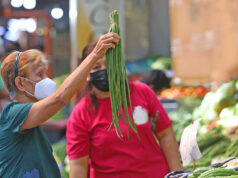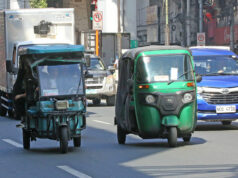A Skeptic Swallows: Dinner at Van Gogh is Bipolar

By Joseph L. Garcia, Reporter
I WILL TELL YOU now that this review will be clouded over by a certain incident. Before going to Maginhawa’s Van Gogh is Bipolar, a restaurant in Quezon City, this reporter was listening to the song “Dominique” by Souer Sourire. I was thinking of a story my mother told me, that in another world, I might have been named Dominic (a variant of the name), because of her and her father’s shared fondness for the song. I was contemplating what life would have been with another name — that name — right before meeting artist and chef Jetro Rafael, the founder of Van Gogh is Bipolar (which we will call Van Gogh from here on in). As I stepped into the restaurant, Mr. Rafael greeted me: “Ah! Dominic.” I then proceeded to interview Mr. Rafael with the sort of wide-eyed curiosity one accords to a magician.
The restaurant’s decor didn’t help much to clear up my vision. One enters the restaurant through a wardrobe, as is the trope in many fantasy novels for children. Mr. Rafael led me away from the wicker and brightness of the restaurant’s “Light” area. “You’ll fit much better here,” he said about the restaurant’s “Shadow” area, bidding me to sit on an antique chair draped with a pelt. This part of the restaurant makes one feel like they were entering the home of a bohemian aunt who told fortunes as a hobby. Teapots and tchotchkes of every shape and size are crammed into shelves, and Mr. Rafael hummed along to music as he set the table (covered with a star chart) with an antique silver Turkish tea set.
The restaurant has been around since 2009, and had been featured at least twice by the BBC. Its menu revolves around food that supposedly improves the mood by stimulating the production of certain neurotransmitters. The search for mood-healing food is centered around Mr. Rafael’s own struggle with bipolar disorder. “I have a background in chemistry, and I grew up in a laboratory. My mother is a medical technologist. More than that, I needed this kind of — I call it natural medicine, homeopathic medicine. For a while, it served as my medicine for my mood disorder — before. Now I can fairly and safely say I’m healed. The last pill I took was 10 years ago.”
He talked about what his condition was like prior to doing research on mentally therapeutic dining, and his dissatisfaction with the anti-psychotic medication he was taking. “Lumobo ako (I swelled up like a balloon). Para akong sedated (it was like I was sedated). Minsan wala akong facial expressions (sometimes I didn’t have facial expressions),” he recalled. He then invited his friends over to dinner made with ingredients that his studies said were good for improving his mood. The name of the restaurant, meanwhile, comes from his friend shooting down two other names for the restaurant, and his third try settled on the blighted artist. “I started creating my own medicine, which I initially called the cuckoo diet (as in the expression for ‘crazy’). Scientifically speaking, it’s mind-healing nutrition. It’s designed nutritionally and biochemically to activate specific neurotransmitters in the brain.” He then ran down a list: “Dopamine, serotonin, GABA, etc. They’re known to make you happy and calm.
“That’s a very simple understanding from my direct experience. I remember. I was taking all these synthetic medications before: mood stabilizers, anti-psychotics… I said that if these pills can make me feel this way — supposedly, the most natural form of it, which are living molecules from food — may also make me feel this way.”
It’s not that he rejects Western models of mental health treatment (we wouldn’t advise you, in any way, to stop any current mental health treatments). “I don’t have issues with science, or medicine. It’s more of the synthetic — I want to emphasize that. It’s not about the West. There are non-synthetic methods of healing,” he said, citing his belief in the field of psychiatry. “I just don’t agree with the synthetic way; the synthetic method of healing. I have an in-house psychiatrist here in Van Gogh. She comes every now and then to share her free services to the community.”
Well, and fine, but we’re still curious about the scientific spine propping up Mr. Rafael’s cooking.
He told us that when the BBC first approached him, they decided to bring the diet plan to a nutrition scientist. We dug up the report on BBC’s website (“Eating your way to happiness in the Philippines” by Kate McGeown, 2012), which said: “According to nutrition experts, there is increasing evidence that he is right — food does have mood-altering properties — although this is still an area of science that needs to be better understood. Dr. Sandrine Thuret, from the Institute of Psychiatry at King’s College London, says the omega-3 in oily fish and flavonoids like those in blueberries, cranberries, and dark chocolate are thought to improve a person’s mood. She believes certain diets might work in a similar way to clinically prescribed anti-depressants.”
HAVING DINNER
For dinner, we sat at a marble-topped table, with its legs from a repurposed old sewing machine. A “life server” at the restaurant (what Mr. Rafael calls the bright, attentive staff; usually they also have mood disorders similar to his) washed my hands with vinegar, baking soda, and warm water. She told me that if I needed assistance, I should ring the antique bell from Tibet on my right. She served me a drink, the Courtney Love Potion (the menu is populated with names of stars who had mental health issues), made with dalandan juice and sprinkled with butterfly pea flowers, said to relieve anxiety. It woke up the palate, at least, though I didn’t like it much — not for anything but a personal aversion to citrus.
The soup came next, a concoction named Virginia Woolf’s Tears (yup), with a mushroom base, vegetables, and quail eggs. It had a light texture but had many layers of flavor, and crisp vegetables and fresh herbs added life to what would have been a staid dining experience (the exotic flavor of mushrooms and citrus in the broth notwithstanding).
The life server then offered me the Axl Rose egg shot, made with a raw egg (which contains amino acids, Omega-3, Vitamin D, and fatty acids for the brain), Jägermeister, and cayenne pepper (which supposedly reduces cortisol, the stress hormone).
I guess that’s the joy in the restaurant: the food is simple, and uncomplicated, and made with a purpose — but then it’s served in such extraordinary surroundings and in such strange ways that it becomes an entirely new experience.
For example: my main course was a fried free-range chicken with a side of rice and vegetables. Mr. Rafael explained the mental health benefits of the dish: the chicken’s white meat contains tryptophan, which the body converts to serotonin. The heirloom black rice from the uplands is high in folic acid and B-vitamins, while a compound from broccoli, according to a study, may increase brain function. Furthermore, every bit of the restaurant the eye may land on stimulates the mind, and begs for an opening to a conversation.
Dessert was served next, called Mel Gibson’s Darkest Sin: absinthe and muscovado sugar flamed in a glass teapot, served as a shot and chased with a dollop of melted dark chocolate (which helps the mind thanks to flavanols, theobromine, and phenylethylamine).
The meal ended with a pot of mood-improving tea — I chose “happy chill,” made from the dried leaves of mango trees.
A SAFE SPACE
In the years since it opened in 2009, Van Gogh has evolved from a restaurant to a mental health community hub: Mr. Rafael says that they’re open every day except Tuesday at lunchtime until 3 p.m., and they open again at 6 p.m.. In the hours between 3 and 6 p.m., the “Light” area serves as a meditation center for what he calls The Love Project.
“Between 1984 and 2005, estimates for the incidence of suicide in the Philippines have increased from 0.23 to 3.59 per 100,000 in males, and from 0.12 to 1.09 per 100,000 in females,” said an article BJPsych International under the UK’s Royal College of Psychiatrists (“Mental Health Services in the Philippines”). Van Gogh is Bipolar can then play a relevant role in the face of increasing diagnoses of mental health issues — not to mention an increasingly harum-scarum world.
“The place that we created is no longer that safe for everybody,” said Mr. Rafael about the world outside Van Gogh. If you just pay attention to what is happening, a lot of those mental illnesses, psychological imabalances, and emotional disturbances happen when we don’t feel safe: in our own body, heart, and mind. It’s like we created our own enemy and there’s constant battling with life. This space is more significant than ever, because it provides you with the need to be okay in our most vulnerable state. You are safe, you are okay (‘even though you’re not okay’). It makes you feel okay,” he said. “If you have these kinds of spaces, not just here but all over the world — it would be a safer place for everybody.”
Asked if it was possible to replicate the experience (or at least, the diet) at home, he said that it went beyond food: “You know who’s really hungry? More than the body, it’s our spirit.”
“I started perceiving the person who I was before: in pain, and in suffering; to be separate from that part of me who understands and deeply loves that part of me,” he said. “When I gave that my attention and love and understanding — the war within me disappeared.”
We parted with the following words: “It’s very important for me to make people understand that love is not a concept. It’s a direct experience of life. It’s a very open, unlimited, non-judging space: and this (Van Gogh) is a symbol of that.”
I left the restaurant with my suspicions still intact, thinking to myself that I may have been had, and maybe the chicken was a bit dry. I did, however, slip into one of the best slumbers and dreams I’ve ever had, and I woke up refreshed and with a purpose as I haven’t done in ages. Was it something I ate? You decide.
Van Gogh is Bipolar is located at 154 Maginhawa St., Teacher’s Village, Quezon City. Set meals range in price from P999 to P3,850. Reservations are advised, and you can make them either through their Facebook page (facebook.com/vgibipolar) or http://bit.ly/VGIB2020.



